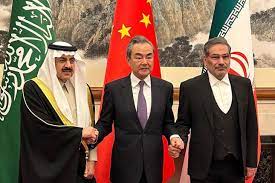Foreign
Global South confident in building equal, orderly multi-polar world

By Huan Yuping, People’s Daily
For some time, discussions on the “Global South” have proliferated around the world. The term refers to the whole of emerging economies and developing countries, and mirrors their collective emergence on the international stage.
As profound changes unseen in a century are evolving rapidly in the world today, these discussions signal an intensifying aspiration of these nations for independent development, solidarity, and cooperation. These countries are becoming a non-negligible force in the international landscape.
I.
In the 1950s and 1960s, some countries that had broken free from the shackles of colonialism and embarked on the path of independent development began using the “South” concept to indicate the systemic inequality between developing countries and industrialized countries, or the “North.” Over several decades, the “Global South” has always pursued peace, development, fairness and justice.
The current focus on the “Global South” has its special context. Since the Ukraine crisis escalated, the international community’s attention to peace, security and development has been raised to new heights.
Some major countries in the West are exploiting the crisis to stir up camp confrontation, and continue to pressure countries whose positions differ from theirs. They even attempted to coerce emerging markets and developing countries to pick sides.
Some Western countries frequently wield unilateral sanctions as a weapon, exerting impacts on the stability of global finance, energy, transport and supply chains. This further drags down the struggling world economy.
Facing such a complex and grim situation, emerging markets and developing countries have maintained a rational attitude. They support peace talks, promote dialogue and negotiations to resolve the Ukraine crisis, firmly resist the hegemony of a few Western countries, and explicitly oppose all forms of unilateralism and the forming of blocs and exclusive groups targeted against particular countries.
Recently, the summit of the EU-Community of Latin American and Caribbean States(CELAC) was held in Brussels, Belgium. During the summit, Latin American countries rejected unilateral demands put forward by the EU on issues such as the Ukraine crisis and trade negotiations, insisting on their own reasonable positions.
This once again demonstrated the increasing focus of emerging markets and developing countries on safeguarding their legitimate rights and interests on the international stage, and on gaining a bigger say in the global governance system.
The sobriety demonstrated by emerging markets and developing countries in a volatile world fully demonstrates their rising strategic independence.
Some international observers believe that the world is witnessing a new “non-aligned movement” as more and more countries are refusing to submit to the United States and pick a side.
Former director of Policy Planning for the U.S. Department of State Anne-Marie Slaughter believes that developing countries’ reactions to the Ukraine crisis represent a much bigger shift in the international order than most American and European analysts give credit for.
A Washington Post article wrote that the non-Western world, the long-neglected Southern Hemisphere, or what is usually referred to as “the rest,” is making its voice heard.
The increasing confidence demonstrated by the “Global South” on the international stage highlights the diverse values and interests of the developing world, reflecting the urgent need to safeguard peace and development and defend fairness and justice.
II.
From a long-term historical perspective, the focus on the “Global South” is an inevitable result of the collective rise of emerging markets and developing countries.
During the Cold War, many developing countries had no choice but to survive between the cracks of the two major camps, with no strategic independence to speak of. Today, the “Global South” represents the vast majority of the world’s population and accounts for half of the global economy. It now stands in a completely different historical position, with an even stronger desire for peace, development and cooperation, as well as greater determination for solidarity and self-strengthening. Its ability to resist hegemony and power politics has significantly improved.
Independence is the political foundation of the “Global South.”
Most developing countries had once been invaded, colonized or plundered. They cherish peace and independence. However, power politics and hegemonic practices are disrupting world peace and have become the biggest destructive factors challenging international peace today.
The “Global South” remains highly vigilant about this and jointly opposes all forms of hegemony and power politics, Cold War mentality, camp confrontation, interference in other countries’ internal affairs, and double standards. It plays a crucial role in maintaining world peace and stability.
Development and rejuvenation are the historical mission of the “Global South.”
UN Secretary-General Antonio Guterres cautioned that without fundamental reforms, the richest countries and individuals will continue to pile up wealth, leaving crumbs for the communities and countries of the Global South.
As the global economic recovery lacks momentum, developing countries face particularly daunting development challenges. Standing at a critical juncture of global development, the “Global South” widely believes that the international community should work together to make global development more inclusive, universal and resilient, and accelerate implementation of the UN 2030 Agenda for Sustainable Development.
The world should adhere to win-win cooperation, reject narrow-minded beggar-thy-neighbor and selfish policies, abandon unilateral approaches that monopolize development advantages, safeguard equal development rights for all countries, and promote common development and prosperity.
Equity and justice are the common proposition of the “Global South.”
A few Western countries incite ideological confrontation, form exclusive cliques, undermine international solidarity and impede global cooperation.
The “Global South” generally believes that the international community should unwaveringly uphold the international system with the UN at the core and the international order underpinned by international law.
It holds that state-to-state relations should be coordinated and regulated through proper institutions and rules, and the strong should not bully the weak. Decision should not be made by simply showing off strong muscles or waving a big fist. Multilateralism should not be used as pretext for acts of unilateralism.
The “Global South” rejects the “rules-based international order” hyped and imposed on the developing world by Western countries. It advocates making the international order more just and reasonable, continuing to increase the representation and voice of emerging markets and developing countries, and promoting the building of an equal and orderly multi-polar world.
In recent years, the “Global South” has seen increasing highlights on the international stage.
The 27th session of the Conference of the Parties to the United Nations Framework Convention on Climate Change(COP 27) successfully established a loss and damage fund to provide financial assistance for vulnerable countries hit hard by climate disasters.
Countries including China, South Africa and Brazil are committed to promoting a political settlement of the Ukraine crisis and steadily building international consensus for peace talks.
The Shanghai Cooperation Organization is steadily advancing its membership expansion, with its cooperative philosophy gaining wider influence.
The BRICS countries are exerting growing influence, with more countries applying to join.
The rise of emerging markets and developing countries has not only led to historic changes in the international balance of power, but also brought new ideas about handling international affairs, injecting new vitality into the entire international relations system.
III.
In June this year, South African President Cyril Ramaphosa remarks at the Summit for a New Global Financial Pact deeply resonated with emerging markets and developing countries: African countries “felt like we were beggars when we needed access to vaccines.” He noted that Western countries were hogging vaccines during the COVID-19 pandemic while African countries were helpless when they needed vaccines most.
In February this year, Ghanaian President Nana Addo Dankwa Akufo-Addo also expressed similar disappointment at the Munich Security Conference. He said some Western countries only took care of themselves and disregarded other countries in urgent need of help.
In the eyes of the “Global South,” some Western countries have long dominated international affairs and prioritized self-interests while neglecting their international responsibilities. Facing the increasingly confident “Global South” in strong demand of strategic independence, a few Western countries feel unaccustomed, uncomprehending, and even furious. They have resorted to threats, inducements, and division, which reflects their ignorance of the history of emerging markets and developing countries, their neglect of the realistic needs of the “Global South,” as well as their arrogant and biased detachment from reality.
Since this year, on multiple occasions like the G7 summit and NATO summit, some Western countries have stepped up their empty show of “paying attention” to emerging markets and developing countries. However, the value of such “attention” can only be tested by actions.
If these Western countries really valued the “Global South,” they should not have fueled the flames in Ukraine and caused the crisis to expand and prolong, or even labeled calls for ceasefire from emerging markets and developing countries as “unacceptable.”
They should not have imposed sanctions and “decoupled” when the “Global South” faced development difficulties, which added serious risks to global economic recovery. They should not have paid only lip service without following through on official foreign aid commitments and funding support for developing countries to cope with climate change.
Martin Wolf, chief economics commentator at the Financial Times, pointed out in his article “The west must recognize its hypocrisy,” that many countries view the United States and European major countries as “selfish, self-satisfied and insincere,” and this view makes perfect sense.
The “Global South” should not be an arena for international political rivalry, nor should it become a tool for major power competition and geopolitical games.
If Western countries really value the “Global South,” they should keep pace with the times and adjust their thinking on international affairs. They should earnestly abide by the purposes and principles of the UN Charter, earnestly respect the rights of emerging markets and developing countries to independently make policies and develop, patiently listen to the latter’s demands, and help them develop and address global challenges like climate change.
Singaporean scholar Kishore Mahbubani said, a reality that the West must accept is that the people of non-Western countries, who today comprise almost 90 percent of the world’s population, want a bigger say in global affairs. The world can only make the right decisions to strengthen multilateralism and the international order based on the UN Charter, otherwise “disorder” will dominate the world, he noted.
China is an ex-officio member of the “Global South” and will always be a member of the big family of developing countries. The increasingly louder voice of the “Global South” in international affairs fully demonstrates that the historical trend toward greater democracy in international relations is unstoppable. As emerging markets and developing countries play an increasingly important role in global governance, the forces defending the basic norms of international relations, upholding international fairness and justice, and promoting world peace and development will continue to grow.
Foreign
Expressway service station in Shandong achieves carbon neutrality

By Li Rui, People’s Daily
A man surnamed Lin, driving a new energy vehicle, was on his way from Jinan to his hometown Weifang, both in east China’s Shandong province. As the battery of his vehicle ran low, he pulled up in a service station along the Qingdao–Yinchuan Expressway.
Experience told him that a service station was a place where drivers and passengers could refuel vehicles, use the bathroom, grab a drink of water and have a meal. However, he found this service station a little bit different.
The Jinan East service station was a key carbon-zero station built by Shandong Hi-Speed Company Limited. It was put into operation on July 26, 2019. During China’s just-concluded National Day holiday, the service station received an average of 13,000 vehicles and 44,000 people on a daily basis.
“How long does it take for a vehicle to get 200 kilometers of range with this ultra-fast charging pole?” Lin asked a staff member of the service station.
“One second for one kilometer of range,” the staff member replied, pointing to an advertising board above that said “Get Fully Charged over a Cup of Coffee.”
Being skeptical about it, Lin scanned a QR code on the charging pole with his phone. Then, he unwound outside his car and went to get a cup of hot water. When he came back, he found his car fully charged.
The power level of the charging pole Lin used was 600 kW, and there were also charging poles of different models and power levels available for users to choose from at the service station.
The Jinan East service station covers an area of 300 mu, or 20 hectares. With so many charging poles in service, it consumes about 6,000 kWh of electricity each day. Where does such a huge load of electricity come from?
On the canopy, rows of solar panels were neatly paved. They were a part of a renewable energy utilization system – a 3.2 MW solar farm built on side slopes of the expressway, parking lot canopies and rooftops. The system also comes with a 3.2 MWh power storage facility.
At present, the service station generates an average of over 10,000 kWh of electricity on a daily basis, far exceeding its daily power consumption volume. This saves 1,200 tons of standard coal per year. The service station also transmits extra electricity to the power grid through safe and efficient means.
At noon, the fragrance of food was floating in the corridors of the crowded comprehensive building of the service station. As one of the busiest service stations in Shandong province, the Jinan East service station welcomes over 10 million passengers each year. How does it manage the wastewater generated by such a huge crowd?
In the “backyard” of the service station, there were two white bungalows at the corner of a tree lawn. Inside them, sewage treatment facilities were running, processing wastewater and pumping it back to the water tanks, which would be used for irrigation and floor washing.
The treatment system for waste and pollutant resources successfully addresses the challenges of the huge variation between water usage peaks and lows, as well as significant greenhouse gas emissions from sewage, effectively recycling and reusing treated water.
“In the past, diesel vehicles were used for service area operations and cleaning, but now they have been replaced with electric vehicles. The catering businesses have also undergone electrification upgrades for their gas stoves, replacing them with clean energy sources wherever possible,” a staff member said.
Carbon emissions are invisible and intangible. How are they measured?
Shandong Hi-Speed Company Limited has independently developed a smart energy management system, which builds a digital twin of the station and displays all relevant data on a screen, including daily electricity generation, charging station power, peak electricity generation periods, air conditioning usage and more.
It is learned that this zero-carbon smart energy management system collects data of all indirect carbon emission sources such as photovoltaics, energy storage, micro grids, lighting, HVAC (heating, ventilation, and air conditioning), and wastewater treatment. It can automatically calculate, make decisions, and intelligently control equipment.
For example, if the air conditioning is set at 26 degrees Celsius indoors, the system can automatically shut down some air conditioners when the temperature falls below this threshold, refining energy management and enabling intelligent equipment control.
According to real-time monitoring by the system, the service station emits an average of 2,060.97 tons of carbon dioxide per year. By planting over 19,000 square meters of greenery, the service station offsets greenhouse gas emissions.
Currently, the forestry area of the service station covers 67,000 square meters, or about 33 percent of the station’s total area. Through forestry carbon sequestration, the system helps reduce an annual average of 3,410.1 tons of carbon dioxide, with a forestry carbon sequestration volume of 53.4 tons of carbon dioxide, realizing “zero-carbon” operations. The service station now has the capability for sustainable carbon neutrality.
“So far, China has built nearly 4,000 pairs of expressway service stations. If we can promote zero-carbon experiences in more service stations, it would be of great significance,” said Zhou Pengfei, deputy director of the energy and environment department of Shandong Hi-Speed Company Limited.
Foreign
Qinling Mountains better safeguarded with comprehensive digital platform

By Zhang Tie, Zhang Danhua, People’s Daily
The Qinling Mountains in northwest China’s Shaanxi province are a natural boundary between China’s north and south in terms of geology, climate, biodiversity, water systems, and soil types.
The unique geographic environment creates abundant moisture, and the rugged terrain harbors rich plant and animal resources, earning the Qinling Mountains the nickname “China’s Central Park” and establishing them as a crucial ecological barrier for the country.
In recent years, ecological protection and restoration of the Qinling Mountains has maintained a priority of Shaanxi province.
“There appears to be waste dumping in the east of Liyuanpo village in Shijing neighborhood,” an alert popped up on the screen of a digital comprehensive monitoring platform for the Qinling Mountains of Huyi district of Xi’an, capital of Shaanxi Province.
Staff member Zhao Na immediately contacted Mao Juan, a local grid officer: “Drones have captured footage, and AI analysis has detected unauthorized dumping.”
In less than an hour, Mao arrived at Liyuanpo village. Upon investigation, she learned that a villager had been renovating his house and had dumped construction waste by the roadside.
She promptly took photos for evidence, uploaded them from her phone, and informed the neighborhood office. After the area was cleared by the following morning, Mao revisited the site, verified the cleanup, and uploaded the update to the platform.
The ecological protection area of the Qinling Mountains covers six districts and counties in Xi’an, accounting for about 55 percent of the city’s total area. The rapid handling of issues like this is a result of an integrated ecological monitoring and protection system for the Qinling Mountains.
The system includes satellites that provide periodic remote sensing images, drones that conduct routine patrol flights, cameras offering real-time monitoring, and 1,240 dedicated grid officers carrying out inspections.
“With this system, countless ‘eyes’ help us protect every ridge and valley of the Qinling Mountains,” said Lei Bo, director of the technology and grid management department of the Xi’an municipal bureau of Qinling ecological environment protection.
From January to August this year, the platform autonomously identified and processed 2,480 cases involving unauthorized construction and dumping. Most cases were resolved within one to three days.
In recent years, Xi’an has continuously improved the systems and mechanisms for regular and long-term protection of the Qinling Mountains. The approach combines human surveillance with technology-based monitoring, and grid-based management with networked coordination, making protection efforts more targeted and intelligent.
Now, the entire landscape can be visualized on a single map, which shows forests, rivers, buildings, and mineral distributions, creates a digital model of the Qinling Mountains.
Each village has its own grid, with at least one grid officer, which forms a four-tiered management system from the municipal level down to villages.
Municipal- and district-level platforms, as well as several industry-specific platforms have been integrated, enabling information sharing and seamless data exchange to form a unified digital supervision system for the Qinling Mountains.
“We can detect even the smallest fire, down to a single lighter, thanks to the integration of thermal, smoke, and light sensors,” said Hua Yiping, director of the Qinling ecological protection and comprehensive law enforcement bureau of Huyi district. The digital monitoring platform now extends to multiple applications, including forest fire prevention, flood control, water quality monitoring, and geological disaster monitoring.
Currently, the populations of wild plants and animals in the Qinling Mountains are steadily increasing, with 99.3 percent of the Qinling area within Shaanxi province now rated as having an excellent ecological environment.
“In the future, we will continue to enhance the automation, intelligence, and precision of Qinling’s protection measures. We aim to refine our monitoring systems and ensure thorough, dynamic inspections and remediation,” said Li Bo, deputy director of the Xi’an municipal bureau of Qinling ecological environment protection.
Foreign
SWChina’s Guizhou builds itself into computing power base serving whole country

By Chen Junyi
At the Gui’an Supercomputing Center, which is located in Guiyang, southwest China’s Guizhou province, over 600 servers are running at full speed, supplying constant computing power to cities like Shenzhen, Guangzhou, and Wuhan, creating a vibrant ambiance with constant hum of cooling fans and flickering indicator lights.
As one of the eight major hubs of China’s national integrated computing power network, Guizhou is actively pursuing the integrated development of data storage and computing, with a particular focus on intelligent computing.
It aims to enhance the capacity in computing power supply, effectively match the supply and demand of computing power within the province and elsewhere, and better utilize computing power and localize the computing industry, so as to establish a support base serving the whole country.
Guizhou launched its plans to develop data centers ten years ago. It boasts numerous natural advantages for developing the computing industry, such as safe geological conditions, reliable power supply, and low average temperatures. China’s three telecommunication operators, namely China Telecom, China Mobile, and China Unicom, have all set up data centers here, making it the first province in China to host data centers of all the three.
After a decade of development, Guizhou is currently home to 47 data centers, either under construction or in operation, including 25 super-large and large data centers, most of which are located in the Gui’an New Area.
The Gui’an New Area is known for its flat terrain and an annual average temperature of 15 degrees Celsius. The region enjoys 99.5 percent of days with good air quality throughout the year, thereby serving as a natural air conditioner and oxygen bar.
The power usage effectiveness (PUE)of data centers in the region, a metric for energy efficiency, is lower than 1.2, which is at the forefront of all green data centers across the country. It is also one of the areas in China where data centers boast the lowest energy consumption and the longest equipment lifespan.
“As the carrier of computing power, data centers are equipped to support high-performance application scenarios by leveraging advanced computational capabilities and large-scale data processing power through the use of various hardware components such as servers and graphics cards,” said Peng Benqian, head of the Gui’an Supercomputing Center and director of the technology research and development department of Gui’an New Area Science and Technology Innovation Industries Development Co., Ltd., the company that runs the center.
In the past, most data centers in Guizhou were primarily focused on storage. With the rapid development of artificial intelligence (AI), Guizhou is advancing intelligent computing, which forms the basis of AI development. The data centers are rapidly transforming from mere “storage centers” to integrated “storage and computing ones.”
The Gui’an Supercomputing Center, the first of its kind in Guizhou, was put into operation at the end of 2020. “We have more than 600 servers, and the peak computing power has reached 130 petaflops,” Peng said.
“It would take nearly 600 years to create special effects rendering for a 3D animated film with a regular computer. However, the whole process can be completed within 3 months at our center,” he said.
In addition to locally built computing power centers, top internet companies such as Huawei, Tencent, and NetEase have established superlarge computing centers and intelligent computing centers in Guizhou. Besides, many banks have set up their financial data centers in the province.
Guizhou has become one of the regions in China with the strongest intelligent computing capabilities. By the end of July 2024, its computing power had reached 40.55 Eflops (a measurement unit used to determine a computer’s speed), with intelligent computing power amounting to 37.578 Eflops, accounting for over 90 percent.
Just like other commodities, computing power cannot be on a perfect supply-demand balance. Idle computing resources will enter a public computing resource pool and be scheduled by the Guizhou branch of China’s national integrated computing power network to efficiently connect the resource side and the demand side.
The transmission and trading of computing power rely on network infrastructure. Guizhou has established direct connections with 38 cities across China, including Beijing, Shanghai, Shenzhen, and Guangzhou.The computing power can meet the huge demand of the “East data, west computing”project, a key part of China’s digital infrastructure which aims to coordinate the computing capabilities of the country’s eastern regions, where the need for computing is high, with inland western regions like Guizhou, where abundant renewable resources are optimal for building data centers, according to Zhang Jie, head of the business department of Gui’an New Area Data Service Technology Co., Ltd.
Meanwhile, Guizhou is leveraging its computing power to drive industrial development and extend the industrial chain. With the support of computing power, many local companies have begun to explore new opportunities.
Guizhou Tuzhi Information Technology Co., Ltd. is a technology company specializing in geospatial big data application and development and a professional provider of real-time spatial-temporal information services integrating air, space, and ground data. With over 8 years of experience, the company has witnessed the evolution of Guizhou’s big data industry.
“The ecosystem of the big data industry in Guizhou is getting better and better, with refined computing power support, industry applications and data transactions. We have seen increasing productivity and expanding business scope,” Huang said.
-

 Politics20 hours ago
Politics20 hours agoGuber Poll: Forum Backs Hon. Umeoji As Anambra’s Best Option
-

 Entertainment21 hours ago
Entertainment21 hours ago“I Have Never Met an Entertainer as Hardworking” – Falz Speaks on His Bond with Funke Akindele
-

 News22 hours ago
News22 hours agoWorld Food Day: FAO Reports Over 3 Million Children Under-5 Stunted Due to Undernutrition in Nigeria
-

 Politics21 hours ago
Politics21 hours agoSouth-South APC Condemns Suspension of Lokpobiri
-

 Business5 hours ago
Business5 hours agoLagos to Shut Down Dumpsites for Waste-to-Energy Project
-

 News5 hours ago
News5 hours agoGovernor Fubara Urges Judges to Uphold Justice, Warns of Divine Judgment
-

 Entertainment21 hours ago
Entertainment21 hours ago“Every Day with You Has Been a Gift” – Olori Ashley Celebrates Ooni of Ife as He Turns 50
-

 Entertainment21 hours ago
Entertainment21 hours ago“Do You Have N500 Billion to Give Me for Introduction and Consultation?” – Jide Kosoko Queries Those Admiring His Daughter






